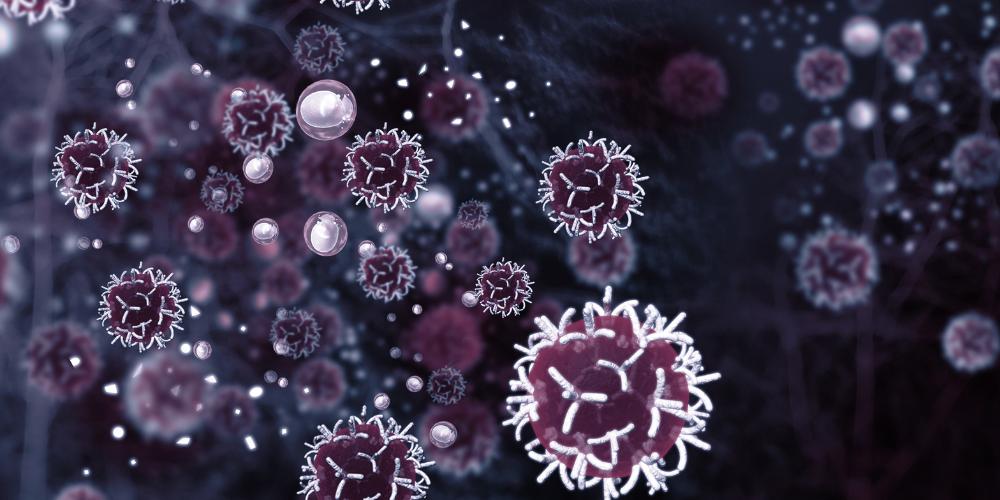RNA Therapeutics for Metastatic Triple-Negative Breast Cancer and Pancreatic Cancer
Veteran RNA researcher, John Rossi, PhD, shares how he’s using his expertise from his decades of work in HIV, to create therapeutics for the treatment of metastatic and solid tumor cancers. Dr Rossi is the Director at the Center for RNA Biology and Therapeutics at City of Hope.

How is your lab looking into RNA applications for cancer?
We use RNA to activate the immune system by turning on genes like the CEBPA gene, which is a key regulatory protein. We are currently investigating small RNA therapy for treatment of metastatic triple negative breast cancer and pancreatic cancer. We have developed RNA aptamers, which we use as targeted small RNA delivery vehicles that will selectively deliver to these cancers. It’s a unique strategy.
What is unique about the use of RNA aptamers?
Aptamers are short, single-stranded DNA or RNA molecules that can selectively bind to a specific target, and can become a variety of shapes. We use aptamers because we can rapidly evolve new RNA structures to bind to any receptor of interest. Furthermore, we can attach other RNAS or DNA oligo to the aptamer to ferry them into cells via receptor binding and internalization of the aptamer.
"It’s a remarkable molecule for therapeutic applications."
Why is the CEBPA gene so interesting?
CEBPA (small RNA gene activation of the C/EBP-α protein) is what I would term a miracle drug. It’s a novel RNA oligonucleotide drug that upregulates C/EBP-α, which is a myeloid transcription factor. Turning on C/EBP-α in immune cells and cancerous cells activates a pathway of tumor suppressors that shuts down cancer cell growth and recruits the cellular immune system to the tumor, which involves switching from M1 to M2 macrophages.
It activates the immune system, isn’t toxic and goes to the right places at the right time. It activates myeloid cells as well as the immune system. It’s being studied in combination with a kinase inhibitor, sorafenib, and also pembrolizumab.
How are you tackling the specific challenges of metastatic cancer?
We’re conjugating small activating RNA with receptors like the transferrin receptor, which is expressed on tumor cells and capable of crossing the blood-brain barrier. With it, we can go after metastases in the brain, as well as the lungs and bones. In metastatic cancer, the metastases are what kill people, not usually their primary tumors.
How are you using RNA to treat pancreatic cancer?
We discovered a new receptor in pancreatic cancer to which we can deliver our RNAs. We’re working with a company out of China to deliver their antisense oligonucleotides to genes that we know will downregulate tumor growth. This is a huge unmet need in solid tumors, that is not really being targeted by current modalities.
The challenge is that solid tumors are surrounded by myeloid cells, almost like an iron wall. We can modulate CAR T cells to successfully recognize solid tumors. Our technology can downregulate myeloid cells so that CAR T cells can get into the tumor.
What do you see as RNA’s specific value in treating cancer immunologically?
The value of RNA in activating the immune system is that we know that our immune systems are geared toward RNA viruses via innate immune mechanisms like toll-like receptors and RNA interference. Through COVID, we know that RNA vaccines are powerful immune stimulators. RNAs are essential in the body, and there are small RNAs that are potentially active in cancer gene expression. These oncogenes can be expressed, and thus can be targeted.
What is it about RNA that you were initially interested in?
My interest in RNA stemmed from the knowledge that RNA is an informational macromolecule as well as a structural molecule. It can also possess catalytic activity like an enzyme. It’s a remarkable molecule for therapeutic applications. I used my work in HIV and RNA interference to learn how to activate or avoid toll-like receptors, and how to target small RNAs and deal with resistance mechanisms.
I’ve been in the RNA field for over 40 years and our knowledge of the genome and what we call the dark genome, which are RNAs expressed but don’t code for anything and are capable of regulating gene expression, have increased exponentially.
"I’ve been in the RNA field for over 40 years and our knowledge of the genome and what we call the dark genome, which are RNAs expressed but don’t code for anything and are capable of regulating gene expression, have increased exponentially."
Share with us a little about the work you did in HIV with RNA?
We first developed catalytic RNAS that targeted and cleaved the HIV RNA genome. We used this in a fence therapy setting to treat HIV patients using autologous hematopoietic stem cell therapies in a small trial of ten patients. We next used a combinatorial RNA therapy in this same setting in which we combined an siRNA targeting HIV with a ribozyme that degraded the chemo chine receptor CCR4 and a third RNA decoy that bound and sequestered the HIV Rev protein. This triple combination circumvented HIV escape mutants and several of the patients receiving this therapy are alive and well today.
How similar/different are the mechanisms of resistance of cancer versus HIV, and how much is transferable about immunotherapy for oncology?
The difference between HIV and cancer resistance to RNA therapies is that HIV replicates with an error-prone enzyme reverse transcriptase generating many mutations per replication cycle. Cancer cells escape RNA therapies by selective motions in the oncogenes and suppression of immunological cells. Thus, RAS can be used to inactivate immunologic suppression.
What are some of the specific discoveries that have excited you about RNA’s use for immuno-oncology?
I’m excited about long non-coding RNAs, which have become very prominent in the RNA field. They bind proteins that regulate and activate the immunity. Dysregulated oncogenes, which are called microRNAs, are potentially active in cancer gene expression and can be targeted. Circular RNAs are fascinating. They’re very stable and unusual. We’ve known about them for a long time but are using them more in therapeutics.
What’s next for your work?
We’re trying to develop drugs that can be delivered by injection with our aptamers. Our transferrin receptor-aptamer can be delivered subcutaneously by a simple injection. It goes to the brain, and across the entire body. That’s a big breakthrough that we’ll be publishing very soon.










